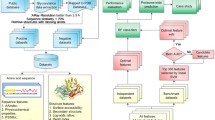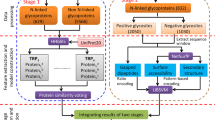Abstract
Protein glycosylation is one of the most important and complex post-translational modification that provides greater proteomic diversity than any other post-translational modification. Fast and reliable computational methods to identify glycosylation sites are in great demand. Two key issues, feature encoding and feature selection, can critically affect the accuracy of a computational method. We present a new O-glycosylation sites prediction method using only amino acid sequence information. The method includes the following components: (1) on the basis of multi-scale theory, features based on multi-scale composition of amino acids were extracted from the training sequences with identified glycosylation sites; (2) perform a two-stage feature selection to remove features that had adverse effects on the prediction, including a stage one preliminary filtering with Student’s t test, and a second stage screening through iterative elimination using novel pairwise comparisons conducted in random subspace using support vector machine. Important features retained are used to build prediction model. The method is evaluated with sequence-based tenfold cross-validation tests on balanced datasets. The results of our experiments show that our method significantly outperforms those reported in the literature in terms of sensitivity, specificity, accuracy, Matthew’s correlation coefficient. The prediction accuracy of serine and threonine residues sites reached 95.7 and 92.7 %. The Matthew correlation coefficient of our method for S and T sites is 0.914 and 0.873, respectively. This method can evaluate each feature with the interactions of the rest of the features, which are still included in the model and have the advantage of high efficiency.


Similar content being viewed by others
References
Bennett EP, Mandel U, Clausen H, Gerken TA, Fritz TA, Tabak LA (2012) Control of mucin-type O-glycosylation: a classification of the polypeptide GalNAc-transferase gene family. Glycobiology 22:736–756
Bewick V, Cheek L, Ball J (2004) Statistics review 13: receiver operating characteristic curves. Crit Care 8:508–512
Blom N (2004) Prediction of post-translational glycosylation and phosphorylation of proteins from the amino acid sequence. Proteomics 4:1633–1649
Cabrera AF, Farina D, Dremstrup K (2010) Comparison of feature selection and classification methods for a brain–computer interface driven by non-motor imagery. Med Biol Eng Comput 48:123–132
Cai Y, Huang T, Hu L, Shi X, Xie L, Li Y (2012) Prediction of lysine ubiquitination with mRMR feature selection and analysis. Amino Acids 42:1387–1395
Cai YD, Chou KC (1996) Artificial neural network model for predicting the specificity of GalNAc-transferase. Anal Biochem 243:284–285
Cai YD, Liu XJ, Xu XB, Chou KC (2002) Support vector machines for predicting the specificity of GalNAc-transferase. Peptides 23:205–208
Centor RM (1991) Signal detectability: the use of ROC curves and their analyses. Med Decis Mak 11:102–106
Chang CC, Lin CJ (2011) LIBSVM : a library for support vector machines. ACM T Intell Syst Techn 2:1–27. http://www.csie.ntu.edu.tw/~cjlin/libsvm
Chen YZ, Tang YR, Sheng ZY, Zhang Z (2008) Prediction of mucin-type O-glycosylation sites in mammalian proteins using the composition of k-spaced amino acid pairs. BMC Bioinform 9:101
Chou KC (1995) A sequence-coupled vector-projection model for predicting the specificity of GalNAc-transferase. Protein Sci 4:1365–1383
Dias NS, Kamrunnahar M, Mendes PM, Schiff SJ, Correia JH (2010) Feature selection on movement imagery discrimination and attention detection. Med Biol Eng Comput 48:331–341
Ding JD, Zhou SG, Guan JH (2011) miRFam: an effective automatic miRNA classification method based on n-grams and a multiclass SVM. BMC Bioinform 12:216
Geoghegan KF, Song X, Hoth LR, Fenga X, Shankera S, Quazib A, Luxenbergb DP, Wrightb JF, Griffora MC (2013) Unexpected mucin-type O-glycosylation and host-specific N-glycosylation of human recombinant interleukin-17A expressed in a human kidney cell line. Protein Expr Purif 87:27–34
Gill DJ, Chia J, Senewiratne J, Bard F (2010) Regulation of O-glycosylation through Golgi-to-ER relocation of initiation enzymes. J Cell Biol 189:843–858
Hansen JE, Lund O, Tolstrup N, Gooley AA, Williams KL, Brunak S (1998) NetOglyc: prediction of mucin type O-glycosylation sites based on sequence context and surface accessibility. Glycoconjugate J 15:115–130
Hidalgo-Muñoz AR, López MM, Galvao-Carmona A, Pereira AT, Santos IM, Vázquez-Marrufo M, Tomé AM (2014) EEG study on affective valence elicited by novel and familiar pictures using ERD/ERS and SVM-RFE. Med Biol Eng Comput 52:149–158
Hou TJ, Li N, Li YY, Wang W (2012) Characterization of domain-peptide interaction interface: prediction of SH3 domain-mediated protein-protein interaction network in yeast by generic structure-based models. J Proteome Res 11:2982–2995
Hou TJ, Xu Z, Zhang W, McLaughlin WA, David CA, Xu Y, Wang W (2009) Characterization of domain-peptide interaction interface: a generic structure-based model to decipher the binding specificity of SH3 domains. Mol Cell Proteomics 8:639–649
Hou TJ, Zhang W, David CA, Wang W (2008) Characterization of domain-peptide interaction interface: a case study on the amphiphysin-1 SH3 domain. J Mol Biol 376:1201–1214
Hou TJ, Zhang W, Wang J, Wang W (2009) The prediction of HIV-1 protease drug resistance by analyzing the protease/drug decomposed interaction energy components. Proteins Struct Funct Bioinform 74:837–846
Jenkins NP, James DC (1996) Getting the glycosylation right: implications for the biotechnology industry. Nat Biotechnol 14:975–981
Julenius K, Molgaard A, Gupta R, Brunak S (2005) Prediction, conservation analysis, and structural characterization of mammalian mucin-type O-glycosylation sites. Glycobiology 15:153–164
Kawashima S, Pokarowski P, Pokarowska M, Kolinski A, Katayama T, Kanehisa M (2008) AAindex: amino acid index database, progress report 2008. Nucleic Acids Res 36:D202
Li BQ, Hu LL, Chen L, Feng KY, Cai YD, Chou KC (2012) Prediction of protein domain with mRMR feature selection and analysis. PLoS ONE 7:e39308
Li BQ, Huang T, Liu L, Cai YD, Chou KC (2012) Identification of colorectal cancer related genes with mRMR and shortest path in protein-protein interaction network. PLoS ONE 7:e33393
Li S, Liu B, Zeng R, Cai Y, Li Y (2006) Predicting O-glycosylation sites in mammalian proteins by using SVMs. Comput Biol Chem 30:203–208
Li XB, Peng SH, Chen J, Lü B, Zhang H, Lai M (2012) SVM-T-RFE: a novel gene selection algorithm for identifying metastasis-related genes in colorectal cancer using gene expression profiles. Biochem Biophys Res Commun 419:148–153
Liang Y, Zhang F, Wang J, Joshi T, Wang Y, Xu D (2011) Prediction of drought-resistant genes in Arabidopsis thaliana using SVM-RFE. PLoS ONE 6:e21750
Ma C, Dong X, Li R, Liu L (2013) a computational study identifies HIV progression-related genes using mRMR and shortest path tracing. PLoS ONE 8:e78057
Peng H, Long F, Ding C (2005) Feature selection based on mutual information: criteria of max-dependency, max-relevance, and min-redundancy. IEEE Trans Pattern Anal Mach Intell 27:1226–1238
Reynders E, Foulquier F, Annaert W, Matthijs G (2011) How Golgi glycosylation meets and needs trafficking: the case of the COG complex. Glycobiology 21:853–863
Schjoldager KTBG, Clausen H (2012) Site-specific protein O-glycosylation modulates proprotein processing deciphering specific functions of the large polypeptide GalNAc-transferase gene family. BBA Gen Subj 1820:2079–2094
Shen JW, Zhang J, Luo XM, Zhu W, Yu K, Chen K, Jiang H (2007) Predicting protein-protein interactions based only on sequences information. PNAS 104:4337–4341
Shieh MD, Yang CC (2008) Multiclass SVM-RFE for product form feature selection. Expert Syst Appl 35:531–541
Sparrow LG, Gorman JJ, Strike PM, Robinson CP, McKern NM, Epa VC, Ward CW (2007) The location and characterisation of the O-linked glycans of the human insulin receptor. Proteins 66:261–265
Tran DT, Ten Hagen KG (2013) Mucin-type O-glycosylation during development. J Biol Chem 288:6921–6929
Vapnik V (1998) Statistical learning theory. Wiley, New York
Walsh G, Jefferis R (2006) Post-translational modifications in the context of therapeutic proteins. Nat Biotechnol 24:1241–1252
Yang ZH, Fang KT, Kotzc S (2007) On the Student’s t-distribution and the t-statistic. J Multivariate Anal 98:1293–1307
Yoon S, Kim S (2009) Mutual information-based SVM-RFE for diagnostic classification of digitized mammograms. Pattern Recogn Lett 30:1489–1495
Yuan ZM, Zhang YS, Xiong JY (2008) Multidimensional time series analysis based on support vector machine regression and its application in agriculture. Sci Agric Sin 41:2485–2492
Zaki N, Wolfsheimer S, Nuel G, Khuri S (2011) Conotoxin protein classification using free scores of words and support vector machines. BMC Bioinform 12:217
Acknowledgments
This work was supported in part by the Research Foundation for the Doctoral Program of Higher Education of China (No. 20124320110002) and Haiyan Wang’s work is partly supported by a grant from the Simons Foundation (#246077).
Author information
Authors and Affiliations
Corresponding author
Electronic supplementary material
Below is the link to the electronic supplementary material.
Rights and permissions
About this article
Cite this article
Chen, Y., Zhou, W., Wang, H. et al. Prediction of O-glycosylation sites based on multi-scale composition of amino acids and feature selection. Med Biol Eng Comput 53, 535–544 (2015). https://doi.org/10.1007/s11517-015-1268-9
Received:
Accepted:
Published:
Issue Date:
DOI: https://doi.org/10.1007/s11517-015-1268-9




